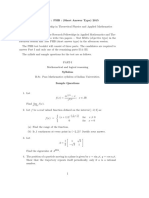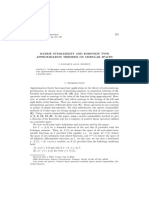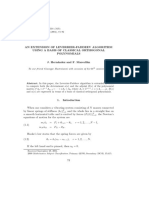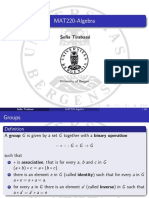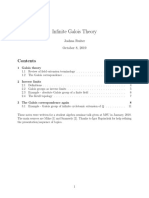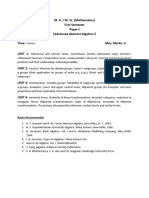JRF in Mathematics 2013
Uploaded by
Ashwin JambhulkarJRF in Mathematics 2013
Uploaded by
Ashwin JambhulkarJRF IN MATHEMATICS 2013
TEST CODE MTA, MTB
There will be two tests MTA and MTB of 2 hours duration each in the forenoon
and in the afternoon. Topics to be covered in these tests along with an outline of
the syllabus and sample questions are given below:
1) Topics for MTA (Forenoon examination) : Real Analysis, Measure and Integration, Complex Analysis, Ordinary Differential Equations and General Topology.
2) Topics for MTB (Afternoon examination) : Algebra, Linear Algebra, Functional
Analysis, Elementary Number Theory and Combinatorics.
Candidates will be judged based on their performance in both the tests.
OUTLINE OF THE SYLLABUS
1. General Topology : Topological spaces, Continuous functions, Connectedness, Compactness, Separation Axioms. Product spaces. Complete metric spaces.
Uniform continuity. Baire category theorem.
2. Functional Analysis : Normed linear spaces, Banach spaces, Hilbert spaces,
Compact operators. Knowledge of some standard examples like C[0, 1], Lp [0, 1].
Continuous linear maps (linear operators). Hahn-Banach Theorem, Open mapping
theorem, Closed graph theorem and the uniform boundedness principle.
3. Real analysis : Sequences and series, Continuity and differentiability of real
valued functions of one variable and applications, uniform convergence, Riemann
integration, continuity and differentiability of real valued functions of several variables, partial derivatives and mixed partial derivatives, total derivative.
4. Linear algebra : Vector spaces, linear transformations, characteristic roots and
characteristic vectors, systems of linear equations, inner product spaces, diagonalization of symmetric and Hermitian matrices, quadratic forms.
5. Elementary number theory and Combinatorics: Divisibility, congruences,
standard arithmetic functions, permutations and combinations, and combinatorial
probability.
6. Lebesgue integration : Lebesgue measure on the line, measurable functions,
Lebesgue integral, convergence almost everywhere, monotone and dominated convergence theorems.
1
7. Complex analysis : Analytic functions, Cauchys theorem and Cauchy integral formula, maximum modulus principle, Laurent series, Singularities, Theory of
residues, contour integration.
8. Abstract algebra : Groups, homomorphisms, normal subgroups and quotients, isomorphism theorems, finite groups, symmetric and alternating groups, direct product, structure of finite Abelian groups, Sylow theorems. Rings and ideals,
quotients, homomorphism and isomorphism theorems, maximal ideals, prime ideals,
integral domains, field of fractions; Euclidean rings, principal ideal domains, unique
factoristation domains, polynomial rings. Fields, characteristic of a field, algebraic
extensions, roots of polynomials, separable and normal extensions, finite fields.
9. Ordinary differential equations : First order ODE and their solutions,
singular solutions, initial value problems for first order ODE, general theory of
homogeneous and nonhomogeneous linear differential equations, and Second order
ODE and their solutions.
SAMPLE QUESTIONS
Topology
(1) Let (X, d) be a compact metric space. Suppose that f : X X is a function
such that
d(f (x), f (y)) < d(x, y) for x 6= y, x, y X.
Then show that there exists x0 X such that f (x0 ) = x0 .
(2) Let X be a Hausdorff space. Let f : X R be such that {(x, f (x)) : x X}
is a compact subset of X R. Show that f is continuous.
(3) Let X be a compact Hausdorff space. Assume that the vector space of
real-valued continuous functions on X is finite dimensional. Show that X
is finite.
(4) Let n > 1 and let X = {(p1 , p2 , . . . , pn )|pi is rational}. Show that X is
disconnected.
(5) Let A = {(x, y) R2 | max{|x|, |y|} 1} and B = {(0, y) R2 |y R}.
Show that the set A + B = {a + b|a A, b B} is a closed subset of R2 .
Functional analysis and Linear algebra
(6) Let y1 , y2 , . . . be a sequence in a Hilbert space. Let Vn be the linear span
of {y1 , y2 , . . . , yn }. Assume that kyn+1 k ky yn+1 k for each y Vn for
n = 1, 2, 3, . . .. Show that hyi , yj i = 0 for i 6= j.
(7) Let E and F be real or complex normed linear spaces. Let Tn : E F be
a sequence of continuous linear transformations such that supn kTn k < .
Let
M = {x E| The sequence {Tn (x)}is Cauchy}.
(8)
(9)
(10)
(11)
(12)
Show that M is a closed set.
Suppose that X is a normed linear space over R and f : X R is a linear
functional. Show that the kernel of f is either closed or dense.
Let X be an infinite dimensional Banach space. Prove that every basis of
X is uncountable.
Let X and Y be complex, normed linear spaces which are not necessarily
complete. Let T : X Y be a linear map such that {T xn } is a Cauchy
sequence in Y whenever {xn } is a Cauchy sequence in X. Show that T is
continuous.
Let H be a Hilbert space and S H be a finite subset. Show that (S )
is a finite dimensional vector space.
Find an n n matrix with real entries whose minimal polynomial is xn1 .
Real Analysis and Measure Theory
(13) Let a1 , a2 , a3 , . . . be a bounded sequence of real numbers. Define
sn =
(a1 + a2 + . . . + an )
, n = 1, 2, 3, . . .
n
Show that lim inf an lim inf sn .
n
(14) Let p (x) be an odd degree polynomial in one variable with coefficients from
the set R of real numbers. Let g : R R be a bounded continuous function.
Prove that there exists an x0 R such that p (x0 ) = g (x0 ).
(15) Suppose that U is a connected open subset of R2 and f : U R is such
f
that f
x 0 and y 0 on U . Show that f is a constant function.
(16) Let f1 , f2 , f3 , . . . and f be nonnegative Lebesgue integrable functions on R
such that
Zy
Zy
lim
fn (x)dx
Z
and lim
Show that lim inf
n
R
U
f (x)dx for each y R
=
Z
fn (x)dx
fn (x)dx
f (x)dx.
f (x)dx for any open subset U of R.
(17) Let f be a uniformly continuous real valued function on the real line R.
Assume that f is integrable with respect to the Lebesgue measure on R.
Show that f (x) 0 as |x| .
R
(18) Let f : R [0, ) be a measurable function. If f (x)dx = 1 then
R
prove that 1+f1(x) dx = . (Hint: First show that m{x : f (x) < 1} =
where m is the Lebesgue measure.)
Elementary Number Theory and Combinatorics
(p1)!
(19) Let p be a prime and r an integer, 0 < r < p. Show that r!(pr)!
is an
integer.
(20) If a and b are integers such that 9 divides a2 + ab + b2 then show that 3
divides both a and b.
(21) Let c be a 3n digit number whose digits are all equal. Show that 3n divides
c.
(22) Prove that x4 10x2 + 1 is reducible modulo p for every prime p.
(23) Does there exist an integer x satisfying the following congruences?
10x = 1(mod 21)
5x
= 2(mod 6)
4x
= 1(mod 7)
Justify your answer.
(24) Suppose that there are n boxes labelled 1, 2, . . . n and there are n balls also
labelled similarly. The balls are thrown into boxes completely randomly so
that each box receives one ball.
(a) How many possible arrangements of balls in boxes is possible?
(b) Find the probability that the ball labelled 1 goes into the box labelled
1.
(c) Find the probability that at least one ball is in the box with the same
label.
Complex Analysis
(25) Suppose for an analytic function f its zero set Zf is uncountable. Show
that f 0.
1
(26) Let f : C C be analytic. Suppose that |f ( n1 )| n3/2
for each n N.
1
2
Prove that {n f ( n )} is bounded.
(27) Let f : C C be continuous. If f 2 and f 3 are analytic prove that f is
analytic at every point of C.
Abstract Algebra
(28) Let Sn denote the group of permutations of {1, 2, 3, . . . , n} and let k be an
integer between 1 and n. Find the number of elements x in Sn such that
the cycle containing 1 in the cycle decomposition of x has length k.
(29) Let C be the field of complex numbers and : C[X, Y, Z] C[t] be the
ring homomorphism such that
(a) = a for all a in C,
(X) = t,
(Y ) = t2 , and
(Z) = t3 .
(30)
(31)
(32)
(33)
Determine the kernel of .
Show that there is no field isomorphism between Q( 2) and Q( 3). Are
they isomorphic as vector spaces over Q?
Let K be a subfield of C not contained in R. Show that K is dense in C.
Determine the additive group of the field of four elements.
Let Z[X] denote the ring of polynomials in X with integer coefficients. Find
an ideal I in Z[X] such that Z[X]/I is a field of order 4.
Differential Equations
(34) Let y : [a, b] R be a solution of the equation
dy
d2 y
+ P (x)
+ Q (x) y (x) = 0,
2
dx
dx
where P (x) and Q (x) are continuous functions on [a, b]. If the graph of
the function y (x) is tangent to X-axis at any point of this interval, then
prove that y is identically zero.
(35) Consider the ordinary differential equation
y 00 (t) + py 0 (t) + qy(t) = 0, t > 0
where p and q are real constants such that p2 4q > 0. Show that |y(t)| 0
as t .
(36) Let p C. Consider the differential equation
u00 (x) p2 u(x) = 0.
If every solution of this equation satisfies
Z T
1
|u(t)|dt < ,
sup
T >0 2T T
prove that Re(p) = 0.
JRF IN MATHEMATICS 2012
TEST CODE MTA
(1) Let a1 , a2 , . . . be a sequence of real numbers with ai 0. If
1
1
1 1+an < , then show that 1 1+xn an < for each real
sequence x1 , x2 , . . ., with xi 0 and lim inf n xn > 0.
(2) Let f : R R be a function with the intermediate value
property: that is, f maps intervals to intervals. Let x R.
Suppose to each sequence (xn ) converging to x there exists a
constant M such that
|f (x) f (xn )| M sup |f (xn ) f (xm )|.
n,m
Then show that f is continuous at x.
(3) Define f1 , f2 , . . . : [0, 1) R as follows: For n = 2k + p,
0 p < 2k
(
1, if t [ 2pk , p+1
)
2k
fn (t) =
0, otherwise.
R1
(a) Show that 0 |fn (t)|dt 0 as n .
(b) Find lim sup fn (t) and lim inf fn (t).
(4) Let m be the Lebesgue measure on R and f : R [0, ) be a
Lebesgue integrable function. Show that there exists a Lebesgue
measurable set E [0, ) such that m(E) 6= m(f 1 (E)).
(5) Let f : R R be a bounded Lebesgue measurable function such that, for all a, b R with < a < b < +,
Rb
f (x) dx = 0.
a
R
(a) Show that E f = 0 for each subset E of R of finite Lebesgue
measure.
(b) Deduce that f = 0 a.e.
(6) Let f : C \ {0} C be an analytic function with a simple pole
of order 1 at 0 with residue a1 . Let g : C C be analytic
1
with g(0) 6= 0. Calculate for r > 0,
Z
1
f (z)g(z) dz.
2i |z|=r
(7) Let f : {z C | 0 < |z| < 1} C be analytic such that
n |f (1/n)| n(3/2) for n = 2, 3, . . .. Assume that z 2 f (z) is
bounded in |z| < 1. Show that f has a pole of order 1 at 0.
(8) Consider the ordinary differential equation
p2
y(t) = 0
4
on R with p C purely imaginary and p 6= 0. Note that
solutions will be complex valued, not necessarily real valued.
(a) Show that the equation has at least one unbounded solution.
(b) If f is any unbounded solution then show that the limit
f (t)
lim
|t| t
y 00 (t) + py 0 (t) +
exists and is nonzero.
(9) The cofinite topology on R is the topology in which a subset
F R is closed if and only if F is either finite or F = R. Let
X = R with the cofinite topology and Y = R with the usual
topology. Show that any continuous map f : X Y is a
constant.
(10) Let X = [1, 1] [1, 1] and Y = {0} [1/2, 1/2]. Give an
example of a continuous map r : X Y such that r(x) = x
for each x Y .
JRF IN MATHEMATICS 2012
TEST CODE MTB
(1) Let A and B be n! n matrices with real entries. Show that the
A I
matrix
has rank n if and only if A is nonsingular
I B
and B = A1 .
(2) Let n be a positive odd integer and let A be a symmetric n n
matrix of integer entries such that aii = 0, i = 1, 2, . . . , n. Show
that the determinant of A is even.
(3) Let A be a n n real matrix with A2 = At . Show that every
real eigen-value of A is either 0 or 1.
(4) Let Q, R denote the fields of rational numbers and real numbers
respectively. Which of the following rings are not isomorphic.
(a) Q[x]/ < x2 + 1 > and Q[x]/ < x2 + x + 1 >.
(b) R[x]/ < x2 + 1 > and R[x]/ < x2 + x + 1 >. Justify your
answer.
(5) Let S4 denote the group of permutations of {1, 2, 3, 4} and let
H be a subgroup of S4 of order 6. Show that there exists an
element i {1, 2, 3, 4} which is fixed by each element of H.
(6) Let R be a commutative integral domain and K be a subring
of R. If K is a field and the dimension of R as a vector space
over K is finite, then show that R is a field.
(7) Let X be a Banach space. Let T : X X be a invertible
linear operator and M > 0 be such that ||T k || M for all
k 1. Prove that inf n1 ||T n (x)|| > 0 for all x 6= 0 in X.
(8) Let X be a Hilbert space and (xn ) be a sequence in X. If
||xn || 1 and xn x weakly for some x in X with ||x|| = 1,
then show that ||xn x||2 0.
1
(9) Show that the number of bijections f of {1, 2, . . . , n} such that
f (i) 6= i for any i is equal to
nj=0 (1)j
n!
.
j!
(10) Find the smallest integer n > 0 such that 2012 divides 9n 1.
(Hint: 251 and 503 are prime numbers).
You might also like
- MA 201: Finite Vibrating String Problem Introduction To Fourier Series Lecture - 9No ratings yetMA 201: Finite Vibrating String Problem Introduction To Fourier Series Lecture - 921 pages
- Iterative Algorithm For Computing FixedNo ratings yetIterative Algorithm For Computing Fixed12 pages
- Qualifying Examination: ⊂ X a closed sub-/ Y) of the complement / Y) = χ (X) + (−1) χ (Y)No ratings yetQualifying Examination: ⊂ X a closed sub-/ Y) of the complement / Y) = χ (X) + (−1) χ (Y)7 pages
- 1990 - Nonexpansive Iterations in Hyperbolic SpacesNo ratings yet1990 - Nonexpansive Iterations in Hyperbolic Spaces22 pages
- Math480/540, TOPICS IN MODERN MATH. What Are Numbers?No ratings yetMath480/540, TOPICS IN MODERN MATH. What Are Numbers?41 pages
- Jordan Product and Analytic Core PreserversNo ratings yetJordan Product and Analytic Core Preservers13 pages
- JRF Mathematics Examination RMI: K nk+1 NKNo ratings yetJRF Mathematics Examination RMI: K nk+1 NK2 pages
- Homological Algebra - Problem Set 1 - SolutionsNo ratings yetHomological Algebra - Problem Set 1 - Solutions9 pages
- MATH 2810 Algebraic Geometry Homework 1 and Some Practice ProblemsNo ratings yetMATH 2810 Algebraic Geometry Homework 1 and Some Practice Problems3 pages
- Fuzzy Normed Linear Spaces and Fuzzy FramesNo ratings yetFuzzy Normed Linear Spaces and Fuzzy Frames26 pages
- Notes On Point Set Topology, Fall 2010: Stephan Stolz September 3, 2010No ratings yetNotes On Point Set Topology, Fall 2010: Stephan Stolz September 3, 201011 pages
- Https WWW - Ee.iitb - Ac.in Bsraj Courses Ee764 hw1No ratings yetHttps WWW - Ee.iitb - Ac.in Bsraj Courses Ee764 hw12 pages
- Admissions Test MSC in Financial Mathematics University of WarwickNo ratings yetAdmissions Test MSC in Financial Mathematics University of Warwick3 pages
- Matrix Summability and Korovkin Type Approximation Theorem On Modular SpacesNo ratings yetMatrix Summability and Korovkin Type Approximation Theorem On Modular Spaces12 pages
- Maxima and Minima: Seeds Insitute Iit/Aieee/PetNo ratings yetMaxima and Minima: Seeds Insitute Iit/Aieee/Pet2 pages
- Seeds Instittute: Motion in One DimensionNo ratings yetSeeds Instittute: Motion in One Dimension1 page
- Quadratic Equation: Date 14/04/11 Class - X D.PPNo ratings yetQuadratic Equation: Date 14/04/11 Class - X D.PP2 pages
- Eds Institute: Pair of Linear Equations in Two VariablesNo ratings yetEds Institute: Pair of Linear Equations in Two Variables3 pages
- Electric Field and Potential: Seeds InstituteNo ratings yetElectric Field and Potential: Seeds Institute2 pages
- Seeds Institute: Centre of Mass, Impulse, MomentumNo ratings yetSeeds Institute: Centre of Mass, Impulse, Momentum1 page
- Seeds Institute: DATE 18.10.2011 Class - XiiNo ratings yetSeeds Institute: DATE 18.10.2011 Class - Xii2 pages
- Seeds Institute: Date 11/08/2011 Class - XIINo ratings yetSeeds Institute: Date 11/08/2011 Class - XII1 page
- Seeds Institute: DATE 14/07/2011 Class - Xii Sources of Emf and Kirchhoff'S Laws DPPNo ratings yetSeeds Institute: DATE 14/07/2011 Class - Xii Sources of Emf and Kirchhoff'S Laws DPP2 pages
- Galois Theory 5th Edition Ian Stewart All Chapter Instant Download100% (4)Galois Theory 5th Edition Ian Stewart All Chapter Instant Download53 pages
- Conversion Methods Between Implicit and Parametric Curves (Hoffman)No ratings yetConversion Methods Between Implicit and Parametric Curves (Hoffman)65 pages
- Immediate download A Book of Abstract Algebra Second Edition English Edition Charles C. Pinter ebooks 2024100% (15)Immediate download A Book of Abstract Algebra Second Edition English Edition Charles C. Pinter ebooks 202460 pages
- Complete Download Algebra and Number Theory A Selection of Highlights 1st Edition Benjamin Fine PDF All Chapters100% (6)Complete Download Algebra and Number Theory A Selection of Highlights 1st Edition Benjamin Fine PDF All Chapters61 pages
- Annexure-37. MSC Mathematics Sep 4 2018No ratings yetAnnexure-37. MSC Mathematics Sep 4 201851 pages
- Algebra in Action A Course in Groups Rings and Fields 1st Edition Shahriar Shahriari downloadNo ratings yetAlgebra in Action A Course in Groups Rings and Fields 1st Edition Shahriar Shahriari download56 pages
- Algebra Abstract and Concrete Stressing Symmetry 2 5 Edition Frederick M. Goodman 2024 scribd download100% (6)Algebra Abstract and Concrete Stressing Symmetry 2 5 Edition Frederick M. Goodman 2024 scribd download60 pages
- Abstract Algebra-Applications To Galois Theory Algebraic Geometry & Cryptography-Carstensen Fine & Rosenberger100% (6)Abstract Algebra-Applications To Galois Theory Algebraic Geometry & Cryptography-Carstensen Fine & Rosenberger379 pages
- Algebra 2 Linear Algebra Galois Theory Representation Theory Group Extensions and Schur Multiplier 1st Edition Ramji Lal 2024 Scribd Download100% (6)Algebra 2 Linear Algebra Galois Theory Representation Theory Group Extensions and Schur Multiplier 1st Edition Ramji Lal 2024 Scribd Download62 pages
- (Lecture Notes in Mathematics 1800) Ofer Gabber, Lorenzo Ramero (Auth.) - Almost Ring Theory-Springer-Verlag Berlin Heidelberg (2003)No ratings yet(Lecture Notes in Mathematics 1800) Ofer Gabber, Lorenzo Ramero (Auth.) - Almost Ring Theory-Springer-Verlag Berlin Heidelberg (2003)313 pages
- Binary Galois Field Table Representation Using C++No ratings yetBinary Galois Field Table Representation Using C++13 pages
- M. A. / M. Sc. (Mathematics) First Semester Paper-I (Advanced Abstract Algebra-I) Time: Max. Marks: Unit 1No ratings yetM. A. / M. Sc. (Mathematics) First Semester Paper-I (Advanced Abstract Algebra-I) Time: Max. Marks: Unit 124 pages
- Women in Numbers Europe Research Directions in Number TheoryNo ratings yetWomen in Numbers Europe Research Directions in Number Theory215 pages
- Galois Theory 2nd Edition David A. Cox 2024 Scribd Download100% (6)Galois Theory 2nd Edition David A. Cox 2024 Scribd Download81 pages
- MA 201: Finite Vibrating String Problem Introduction To Fourier Series Lecture - 9MA 201: Finite Vibrating String Problem Introduction To Fourier Series Lecture - 9
- Qualifying Examination: ⊂ X a closed sub-/ Y) of the complement / Y) = χ (X) + (−1) χ (Y)Qualifying Examination: ⊂ X a closed sub-/ Y) of the complement / Y) = χ (X) + (−1) χ (Y)
- 1990 - Nonexpansive Iterations in Hyperbolic Spaces1990 - Nonexpansive Iterations in Hyperbolic Spaces
- Math480/540, TOPICS IN MODERN MATH. What Are Numbers?Math480/540, TOPICS IN MODERN MATH. What Are Numbers?
- MATH 2810 Algebraic Geometry Homework 1 and Some Practice ProblemsMATH 2810 Algebraic Geometry Homework 1 and Some Practice Problems
- Notes On Point Set Topology, Fall 2010: Stephan Stolz September 3, 2010Notes On Point Set Topology, Fall 2010: Stephan Stolz September 3, 2010
- Https WWW - Ee.iitb - Ac.in Bsraj Courses Ee764 hw1Https WWW - Ee.iitb - Ac.in Bsraj Courses Ee764 hw1
- Admissions Test MSC in Financial Mathematics University of WarwickAdmissions Test MSC in Financial Mathematics University of Warwick
- Matrix Summability and Korovkin Type Approximation Theorem On Modular SpacesMatrix Summability and Korovkin Type Approximation Theorem On Modular Spaces
- An Introduction to Linear Algebra and TensorsFrom EverandAn Introduction to Linear Algebra and Tensors
- Eds Institute: Pair of Linear Equations in Two VariablesEds Institute: Pair of Linear Equations in Two Variables
- Seeds Institute: Centre of Mass, Impulse, MomentumSeeds Institute: Centre of Mass, Impulse, Momentum
- Seeds Institute: DATE 14/07/2011 Class - Xii Sources of Emf and Kirchhoff'S Laws DPPSeeds Institute: DATE 14/07/2011 Class - Xii Sources of Emf and Kirchhoff'S Laws DPP
- Galois Theory 5th Edition Ian Stewart All Chapter Instant DownloadGalois Theory 5th Edition Ian Stewart All Chapter Instant Download
- Conversion Methods Between Implicit and Parametric Curves (Hoffman)Conversion Methods Between Implicit and Parametric Curves (Hoffman)
- Immediate download A Book of Abstract Algebra Second Edition English Edition Charles C. Pinter ebooks 2024Immediate download A Book of Abstract Algebra Second Edition English Edition Charles C. Pinter ebooks 2024
- Complete Download Algebra and Number Theory A Selection of Highlights 1st Edition Benjamin Fine PDF All ChaptersComplete Download Algebra and Number Theory A Selection of Highlights 1st Edition Benjamin Fine PDF All Chapters
- Algebra in Action A Course in Groups Rings and Fields 1st Edition Shahriar Shahriari downloadAlgebra in Action A Course in Groups Rings and Fields 1st Edition Shahriar Shahriari download
- Algebra Abstract and Concrete Stressing Symmetry 2 5 Edition Frederick M. Goodman 2024 scribd downloadAlgebra Abstract and Concrete Stressing Symmetry 2 5 Edition Frederick M. Goodman 2024 scribd download
- Abstract Algebra-Applications To Galois Theory Algebraic Geometry & Cryptography-Carstensen Fine & RosenbergerAbstract Algebra-Applications To Galois Theory Algebraic Geometry & Cryptography-Carstensen Fine & Rosenberger
- Algebra 2 Linear Algebra Galois Theory Representation Theory Group Extensions and Schur Multiplier 1st Edition Ramji Lal 2024 Scribd DownloadAlgebra 2 Linear Algebra Galois Theory Representation Theory Group Extensions and Schur Multiplier 1st Edition Ramji Lal 2024 Scribd Download
- (Lecture Notes in Mathematics 1800) Ofer Gabber, Lorenzo Ramero (Auth.) - Almost Ring Theory-Springer-Verlag Berlin Heidelberg (2003)(Lecture Notes in Mathematics 1800) Ofer Gabber, Lorenzo Ramero (Auth.) - Almost Ring Theory-Springer-Verlag Berlin Heidelberg (2003)
- Binary Galois Field Table Representation Using C++Binary Galois Field Table Representation Using C++
- M. A. / M. Sc. (Mathematics) First Semester Paper-I (Advanced Abstract Algebra-I) Time: Max. Marks: Unit 1M. A. / M. Sc. (Mathematics) First Semester Paper-I (Advanced Abstract Algebra-I) Time: Max. Marks: Unit 1
- Women in Numbers Europe Research Directions in Number TheoryWomen in Numbers Europe Research Directions in Number Theory
- Galois Theory 2nd Edition David A. Cox 2024 Scribd DownloadGalois Theory 2nd Edition David A. Cox 2024 Scribd Download















